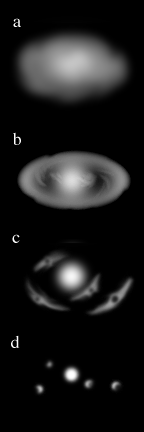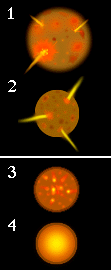Lectures 3 and 4:
Origin and Differentiation of the Earth
"One gets such wholesale returns of conjecture
out of such a trifling investment of fact"
Mark Twain
"Refrain from illusions, insist on work and
not words. Patiently search divine and scientific
truth"
Mendeleyev's Mother (not known for her humor)
Summary of Topics Covered:
-
Approximate ages of universe, solar system, sun, Earth.
-
What are 5 observations that a succesful theory of the solar system explain
-
Oribt of planets about sun in a CCW direction and near an ecliptic plane
-
Consistent rotation of planets (excepting Venus and Uranus)
-
Titius-Bode rule: Each planet is roughly twice as far as the next
inner one from the Sun
-
This arithmetic configuration led to the discovery of the asteroid belt
-
Sun has 99% of the mass, while large planets have 99% of angular
momentum
-
Two groups of planets, Terrestrial and Giants
-
M,V,E,M 4-4.5 g/cm^3
Fe, Mg, Si, O
-
J,S,U,N
0.7-1.7g/cm^3 H,He
-
Study of other planets permits tests of the Chemical-Condendsation Sequence
-
Primative Solar Nebula
-
Condensation to planetary materials
-
Accretion into planets
-
Planetary Evolution
-
Bombardment
-
Igneous differentiation
-
Formation of crust, core, atmoshpheres
-
Why were there individual planetary evolutions?
-
Size
(Insulation)
-
Speed of Accretion (Kinetic energy
to heat)
-
Composition
(Radioactive components?)
-
Distance from Sun
(Solar flux/heat)
Each of these helps govern the thermal evolution.
Some questions to consider:
-
What is the composition of the solar system? I.e., what elements
comprise most of its mass, where can they be found in abundance?
-
How did formation of the solar system create and redistribute the elements?
-
Why is the Earth comprised predominantly of elements that are not representative
of the elements that make up most of the mass of the solar system?
-
Why was the Earth originally not a differentiated body?
-
If the Earth were initially homogenous in composition, how did we arrive
at what we see today?
-
What is the thermal history of the Earth, i.e. how did its geotherm
vary with time?
Stages of the Earth's Accretion and Differentiation that affected its
thermal structure:
-
Bombardment
-
Gravitational Compression
-
Radioactive Heating
Just after the accretion, the Earth is a homogeneous, undifferentiated
planet with an average temperature of ~1000 C.
As the Earth began to warm up, in response to 1, 2, and principally
3 above, it moved through the following stages
-
Iron Catastrophe (formation of Iron core as geotherm heats up
beyond the melting point of iron).
-
Possible formation of a magma ocean through voluminous volcanic eruptions
which provide gases for formation of the atmosphere and eventually the
oceans.
-
Continued differentiation leads to "chemical zonation"
This last stage, chemical zonation, continues today as the Earth
convects and melts.
 Note about Chemical Zonation: Chemical and Behavioral
Zonation are often different beasts! Keep this in mind throughout
the course!
Note about Chemical Zonation: Chemical and Behavioral
Zonation are often different beasts! Keep this in mind throughout
the course!
Some further notes on the early formative history of the Earth.
 Following
the formation of the universe (about 12-20 billion years ago), one of the
early stars began to run out of Hydrogen fuel. This star expanded to a
red giant and then collapsed on itself and exploded in a supernova. In
this supernova, like billions that have occurred elsewhere in our Universe,
all of the other elements were created.
Following
the formation of the universe (about 12-20 billion years ago), one of the
early stars began to run out of Hydrogen fuel. This star expanded to a
red giant and then collapsed on itself and exploded in a supernova. In
this supernova, like billions that have occurred elsewhere in our Universe,
all of the other elements were created.
I. The mass of new matter again collapsed into a disk shape mass of
dust and gas
(a). The center became superheated and formed a new star, our sun
(b). From this disk of matter the planets began to condense
(c), according to the widely supported nebular hypothesis of Immanuel
Kantand Pierre-Simon Laplace. The two strongest points in favor of this
idea are: 1) that the disk began by rotating in one direction and the rotation
of all of the planets around the sun follows the original disk; and 2)
that because the disk flattened out as time progresses, all of the orbits
of the planets (except Pluto) lie more or less in the same plane
(d). Pluto is possibly a captured giant asteroid.
 III.
The earth condensed in four basic steps. 1) It began to accrete from
III.
The earth condensed in four basic steps. 1) It began to accrete from
the nebular cloud as particles smashed into each other forming
so-called
planetesimals. These in turn collided with each other and as their
mass
grew began to gather material from the nebular disk. 2) As the mass
of the
Earth grew so did it's gravitational force and the Earth began to compress
itself into a smaller and denser body. This happened about 4.5 billion
years ago. 3) In the third step the compression itself began to heat
the
interior of the Earth; also there was heat generated by radioactive
decay.
The interior of the earth began to melt. Because iron is the heaviest
of the
common elements that make up the Earth, as the Earth began to melt
droplets of melted iron began to sink towards the center of the earth,
where
they condensed. 4) Proceeding slowly at first it sped up to catastrophic
proportions - hence it is called the iron catastrophe. Note that
3 and 4 in
the figures to the right are cross sections
 III.
The earth condensed in four basic steps. 1) It began to accrete from
III.
The earth condensed in four basic steps. 1) It began to accrete from
 Following
the formation of the universe (about 12-20 billion years ago), one of the
early stars began to run out of Hydrogen fuel. This star expanded to a
red giant and then collapsed on itself and exploded in a supernova. In
this supernova, like billions that have occurred elsewhere in our Universe,
all of the other elements were created.
Following
the formation of the universe (about 12-20 billion years ago), one of the
early stars began to run out of Hydrogen fuel. This star expanded to a
red giant and then collapsed on itself and exploded in a supernova. In
this supernova, like billions that have occurred elsewhere in our Universe,
all of the other elements were created.